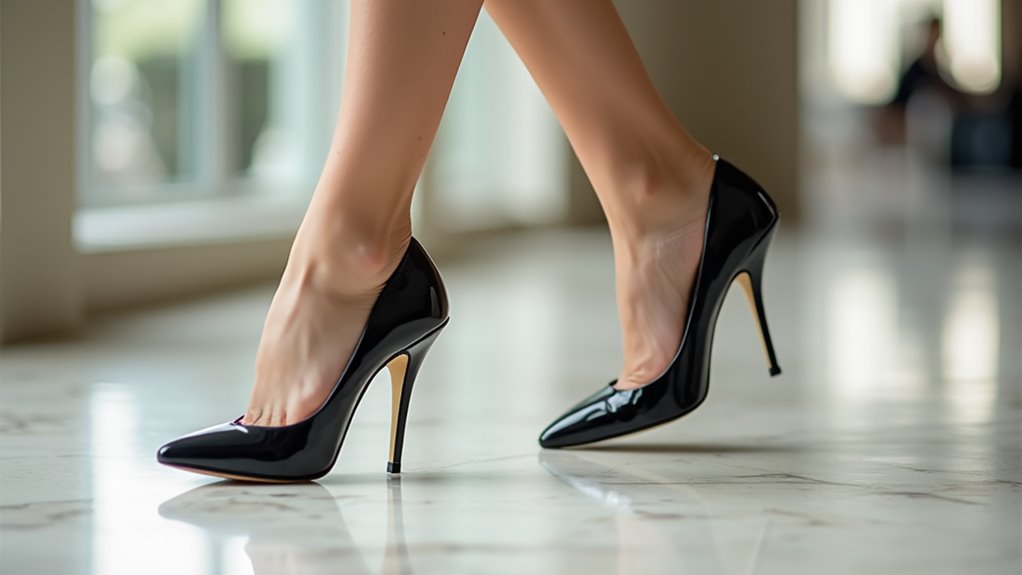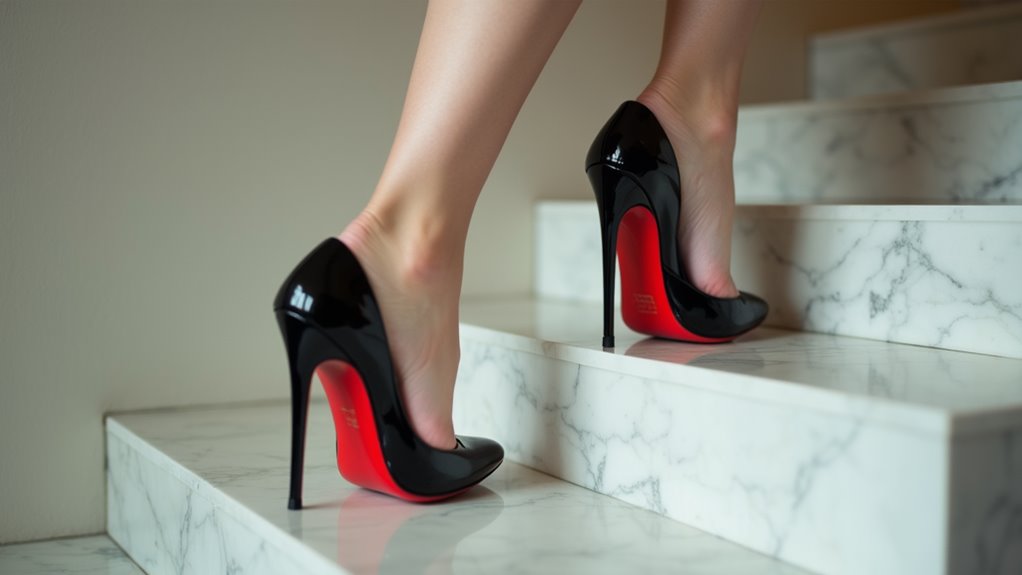There may be products. Products are independently selected by our editors. We may earn an affiliate commission from the links with no charge to you, example: as Amazon Affiliate.
You’ve probably never considered that the way you position your hips while walking in heels can make the difference between looking like a seasoned professional or an awkward novice. It’s not just about putting one foot in front of the other – there’s actually a science behind mastering high heel techniques that involves biomechanics, posture, and strategic muscle engagement. Whether you’re navigating corporate corridors or social events, understanding these professional methods won’t just improve your appearance – it’ll protect your body from strain and help you maintain confidence throughout long days in elevated footwear.
Key Takeaways
- Maintain a straight spine with shoulders back while engaging core muscles to ensure proper posture and balance.
- Practice heel-to-toe rolling motion when walking, taking small controlled steps with toes pointed forward.
- Start with 2-3 inch heels and gradually increase height as you build confidence and skill.
- Strengthen your core through regular exercises like planks and stability ball crunches to improve balance.
- Distribute weight evenly across the foot and practice on various surfaces to develop adaptability and control.
Select the Perfect Heel Height

How do you find the ideal heel height that balances style with comfort? Start by assessing your foot shape and testing your talus bone’s flexibility, as these factors significantly influence your optimal heel height.
If you’re petite, you’ll likely find comfort in 2-3 inch heels, while taller individuals can explore various heights.
Consider your daily activities when selecting heels. If you’re on your feet most of the day, stick to lower heights. For special occasions, you can opt for 3-4 inch heels.
Don’t forget to check the heel’s width and platform features, as these affect stability and comfort. Add cushioning insoles or gel pads to enhance comfort, and always test your heels by walking in them.
Modern technology has introduced impact reducing heels that minimize foot strain while maintaining elegance.
Take small steps and maintain proper posture while practicing in front of a mirror.
Master Your Body Alignment
To walk gracefully in heels, you’ll need to keep your spine straight while pulling your shoulders back and engaging your core muscles.
Your head should stay lifted with your chin parallel to the ground, creating a confident posture from head to toe. You can achieve this alignment by imagining a string pulling you up from the crown of your head while keeping your stomach muscles tight and your pelvis properly positioned.
Straight Spine, Strong Core
Mastering proper body alignment is crucial when wearing high heels, as these shoes can significantly impact your spine and core stability. To protect your back, engage your core muscles throughout the day and maintain awareness of your posture. Regular yoga and Pilates can help strengthen these essential muscles.
Don’t wear high heels daily, as they can lead to chronic back pain and posture imbalances, including a tilted pelvis and forward head position. Instead, alternate between different heel heights and shoe types.
When you do wear heels, opt for lower options like kitten heels or wedges to reduce spinal strain. Remember to stretch your hip flexors and calves regularly, and consider chiropractic treatments to maintain proper alignment.
These preventive measures will help you avoid the long-term effects of spinal stress and muscle imbalances.
Perfect Head-to-Toe Positioning
Proper head-to-toe alignment is essential for safely navigating life in high heels. When you’re walking, keep your head aligned with your spine while maintaining a straight posture. Your pelvis will naturally tilt backward, so focus on engaging your core muscles to prevent excessive lumbar flattening.
Step forward using a forefoot technique, similar to a sprinter’s movement, landing on the ball of your foot first. You’ll need to adjust your center of gravity as high heels shift your body’s weight forward. Choose pumps with wider heels to improve stability.
Be mindful of your knee position, as heels increase knee flexion and change your ankle alignment. To reduce muscle fatigue and maintain proper form, activate your trunk muscles and keep your spine aligned from head to pelvis.
Perfect Your Stepping Technique

When walking in high heels, you’ll need to master the heel-to-toe rolling motion by allowing your heel to strike first, followed by a smooth roll through the sole to the toe.
You can maintain better stability by distributing your weight evenly across your entire foot during each step, rather than placing too much pressure on the ball of your foot or heel.
Practicing this controlled stepping motion will help you move gracefully and reduce strain on your feet and ankles.
For maximum comfort while practicing these techniques, choose formal heels designed specifically with ergonomic features and cushioning.
Heel-to-Toe Rolling Motion
The heel-to-toe rolling motion forms the foundation of graceful walking in high heels. To master this technique, you’ll need to focus on placing your heel down first, then smoothly rolling forward onto the ball of your foot before pushing off with your big toe.
| Action | Technique |
|---|---|
| Step 1 | Place heel firmly on ground |
| Step 2 | Roll foot forward smoothly |
| Step 3 | Transfer weight to ball of foot |
| Step 4 | Push off with big toe |
| Step 5 | Maintain straight posture |
Practice this motion while sitting or standing to develop muscle memory. Keep your spine straight and legs slightly bent at the knees. You’ll engage underused muscles in your shins and calves as you perfect this form. Remember to point your toes forward and align them with your direction of movement while maintaining a natural, comfortable stride length.
Master Your Weight Distribution
Mastering weight distribution stands as a critical skill for confident high-heel walking. You’ll need to evenly distribute your weight between both feet while maintaining proper posture with your shoulders back and chest out.
Practice the Y-step technique, leading with the balls of your feet to minimize heel pressure and prevent accidents.
For optimal weight distribution and stability, follow these essential steps:
- Start by placing your heel down first, followed by rolling to your toes
- Keep your core muscles engaged throughout your walk
- Center your weight evenly over both feet
- Maintain a wider base of support when possible
Practice these techniques in front of a mirror to perfect your form, and strengthen your core through exercises like planks and squats to improve your overall balance and stability.
Build Core Strength
Building core strength serves as a fundamental pillar for comfortable high heel walking.
You’ll notice immediate improvements in your balance, posture, and stability when you focus on strengthening your core muscles. These improvements help reduce lower back pain and prevent potential injuries while wearing heels.
Start with basic exercises like stability ball crunches and leg raises to build your foundation.
As you progress, incorporate planks and heel touches to challenge your core stability. Remember to engage your abdominal muscles while walking by slightly contracting them and maintaining proper breathing.
Aim to train your core at least three times weekly, gradually increasing the intensity of your workouts.
Through consistent practice, you’ll develop the endurance needed to walk confidently and comfortably in your high heels.
Much like finding balance in desert landscapes, mastering core strength requires patience and adaptability to challenging conditions.
Practice Your Walking Form

Now that your core is strong, proper walking form will help you navigate confidently in high heels. Start by placing your heel first, then roll your foot forward to the toe while keeping your back straight and shoulders back. Engage your core and maintain a slight bend in your knees to absorb shock and stay balanced.
When walking, follow these essential steps:
- Place your feet in a straight line, keeping your toes pointed forward
- Take small, controlled steps to maintain stability
- Keep your head up and aligned with your spine
- Let your arms swing naturally at your sides
Practice on different surfaces to improve your adaptability, and use railings for support when climbing stairs. Remember to step with the ball of your foot going up stairs and use your entire foot when descending. For maximum comfort and stability, choose premium comfort heels designed with enhanced cushioning and support.
Optimize Your Stance
A proper stance forms the foundation of walking confidently in high heels. Stand tall with your shoulders back, and distribute your weight slightly forward over the balls of your feet. Keep your feet parallel and hip-width apart while maintaining a gentle bend in your knees. For maximum comfort and stability, choose comfort-focused heel styles that provide adequate support throughout your stride.
| Position | Action |
|---|---|
| Head | Look forward, chin parallel to ground |
| Core | Engage abdominal muscles, pull stomach in |
| Shoulders | Roll back and down, stay relaxed |
| Feet | Point toes forward, heels slightly together |
To enhance your stability and elegance, activate your core muscles and maintain body tension. Don’t lock your knees or lean backward, as this can compromise your balance. Keep your ankles relaxed and remember to align your body in one continuous line from head to toe.
Control Your Walking Speed

Once you’ve mastered your stance, controlling your walking speed becomes your next focus. Start with slow, deliberate steps to maintain balance and stability. You’ll feel more confident as you practice walking at a controlled pace, allowing better command over your movements.
Keep these essential speed control techniques in mind:
- Take smaller strides to prevent overextending and maintain stability.
- Land heel-first, then roll onto the ball of your foot for fluid movement.
- Engage your core muscles to enhance balance while walking.
- Practice on different surfaces to improve your overall control.
Remember to start with short practice sessions and gradually increase your walking time. Focus on proper foot placement, landing on the balls of your feet when needed, and maintaining a comfortable stride length that works for you. For maximum comfort during extended wear, consider investing in comfort pumps designed specifically for all-day walking and standing.
Handle Different Walking Surfaces
Mastering different walking surfaces in high heels requires strategic preparation and practice. Start with wider heels or wedges on carpeted floors to build confidence, then gradually progress to more challenging surfaces.
When navigating stairs, place the ball of your foot first while going up and use your entire foot when descending.
For outdoor surfaces, adapt your technique accordingly. On inclines, push forward with your toes and use your arms for balance. On declines, keep your knees relaxed to absorb impact.
Always maintain proper posture by keeping your shoulders back and head high. Take smaller steps and follow an imaginary straight line to maintain stability. Don’t forget to use railings or other supports when available, especially on slippery surfaces or uneven terrain.
Choose comfort-focused heels that provide adequate cushioning and support for extended wear on various surfaces.
Conclusion
You’re well on your way to dancing with clouds in those towering beauties! By following these tried-and-true techniques, you’ll transform from a wobbly wanderer to a confident strutter. Remember, Rome wasn’t built in a day, and neither is heel-walking expertise. Keep practicing these steps, and you’ll soon be gliding through life with grace and poise, turning heads for all the right reasons.

